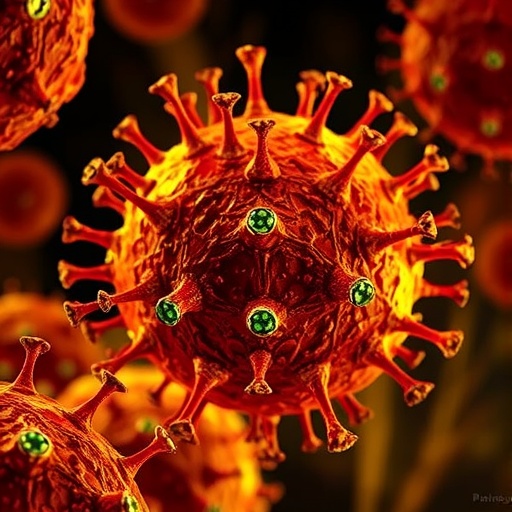In an era increasingly defined by the arms race between host immune defenses and viral pathogens, recent research has unveiled a critical metabolic adaptation within macrophages that enhances antiviral immunity. A team led by Xia, Mao, Xia, and colleagues has revealed that macrophages undergo a sophisticated metabolic rerouting through the aspartate–argininosuccinate shunt, culminating in the production of fumarate, a key metabolite now recognized as a pivotal antiviral agent. Published in Nature Microbiology in 2025, these findings illuminate a nuanced interface between cellular metabolism and innate immune defense, broadening our comprehension of how immune cells leverage metabolic pathways to curb viral infections.
Macrophages are frontline sentinels of the immune system, orchestrating pathogen clearance through phagocytosis, cytokine secretion, and antigen presentation. Beyond these classical roles, their metabolic state is now understood to be a decisive factor in modulating immune responses. The intricate metabolic remodeling described by Xia et al. underscores how macrophages dynamically manipulate their biochemical networks to achieve an optimal antiviral state. Central to this metabolic remodeling is the aspartate–argininosuccinate shunt, a less-explored pathway that diverges from the canonical tricarboxylic acid (TCA) cycle but ultimately feeds into fumarate production.
Fumarate, traditionally viewed as a mere intermediate in the TCA cycle, emerges in this study as a molecule of immunological import. By elevating fumarate levels through the aspartate–argininosuccinate shunt, macrophages appear to enhance antiviral defenses in a manner that transcends conventional cytokine-mediated pathways. This metabolic metabolite exerts multiple intracellular effects, including modulation of redox balance, epigenetic remodeling, and direct interactions with viral components, thereby impeding viral replication and spread. These insights redefine fumarate from a simple metabolic intermediate to a critical effector in innate immunity.
At the biochemical core of this antiviral mechanism is the interplay between aspartate metabolism and the arginine biosynthetic pathway. The aspartate–argininosuccinate shunt connects these two axes, rerouting intermediates away from energy production towards immune effector function. Specifically, the pathway converts aspartate and citrulline into argininosuccinate, subsequently yielding arginine and fumarate. This shunt operates in tandem with nitric oxide synthase to regulate nitric oxide levels, which are crucial for antiviral signaling. The coordinated upregulation of this shunt in virus-infected macrophages signifies an adaptive metabolic reprogramming tailored to immune defense.
The study employs cutting-edge metabolomic profiling and isotopic tracing to elucidate flux through the aspartate–argininosuccinate shunt during viral infection. These methodologies enable precise quantification of metabolite levels and labeling patterns, confirming that fumarate is not merely accumulated but actively synthesized through this specialized shunt. Importantly, pharmacological inhibition of key enzymes within this pathway results in diminished fumarate production and concomitant enhancement of viral proliferation, underscoring the functional relevance of this metabolic circuit in antiviral defense.
Building upon these findings, the researchers explore the downstream signaling cascades influenced by fumarate accumulation. Among the notable discoveries is the role of fumarate in stabilizing hypoxia-inducible factor 1-alpha (HIF-1α), an important transcriptional regulator of immune genes. Fumarate-induced inhibition of prolyl hydroxylases leads to sustained HIF-1α activity, which in turn enhances expression of antiviral genes and pro-inflammatory mediators. This axis forms a crucial link between metabolic state and immune gene transcription, positioning fumarate as a key immunometabolic regulator.
Moreover, fumarate’s ability to modulate epigenetic landscapes emerges as a vital aspect of the antiviral response. By inhibiting histone demethylases through covalent modification, fumarate influences chromatin accessibility and gene expression patterns that favor antiviral immunity. This epigenetic reprogramming provides macrophages with a durable means to maintain heightened immune vigilance even after the initial viral insult subsides, offering potential insights into trained immunity mechanisms driven by metabolic intermediates.
This research holds profound implications for therapeutic innovation. By targeting metabolic enzymes that regulate the aspartate–argininosuccinate shunt or modulating fumarate levels, it may be possible to enhance innate antiviral defenses without relying solely on traditional immunomodulatory agents. Such approaches could ameliorate viral diseases, particularly in cases where the virus subverts classical immune pathways or in immunocompromised individuals. The prospect of metabolic immunotherapy introduces a novel dimension to antiviral strategy development.
Beyond immediate therapeutic applications, the findings contribute to a broader conceptual framework where metabolism is integrated as a fundamental determinant of immune competence. This challenges the historically reductionist view that separates metabolism from immunity, instead emphasizing their bidirectional crosstalk. The aspartate–argininosuccinate shunt exemplifies how metabolic flexibility empowers immune cells to translate environmental cues into tailored functional outputs, shaping the course of infection and host defense.
Notably, the study addresses potential caveats and future directions. While fumarate’s antiviral roles are compelling, its pleiotropic effects necessitate cautious interpretation to avoid unintended consequences such as excessive inflammation or tissue damage. Future research will need to delineate context-specific responses and identify regulatory checkpoints that fine-tune fumarate-mediated immunity. Furthermore, expanding investigations into other immune cell types and viral models will clarify the generalizability of this metabolic mechanism.
In conclusion, the elucidation of fumarate production through the aspartate–argininosuccinate shunt in macrophages unveils a novel and vital metabolic facet of antiviral defense. This discovery enriches the landscape of immunometabolism, linking cellular bioenergetics and innate immunity in unprecedented ways. As viral pandemics continue to challenge global health, understanding and harnessing such metabolic pathways offer promising avenues for innovative antiviral therapies and improved immune resilience.
Subject of Research: Metabolic remodeling in macrophages as an antiviral defense mechanism
Article Title: Metabolic remodelling produces fumarate via the aspartate–argininosuccinate shunt in macrophages as an antiviral defence
Article References:
Xia, W., Mao, Y., Xia, Z. et al. Metabolic remodelling produces fumarate via the aspartate–argininosuccinate shunt in macrophages as an antiviral defence.
Nat Microbiol (2025). https://doi.org/10.1038/s41564-025-01985-x
Image Credits: AI Generated
Tags: aspartate-argininosuccinate shuntcellular metabolism and immune defensefumarate production in immune cellshost defenses against viral pathogensimmune cell metabolic remodelinginnate immune response to virusesmacrophage metabolism and antiviral immunitymacrophage phagocytosis and cytokine secretionmetabolic adaptation in macrophagesmetabolic pathways in viral infectionsrole of fumarate in antiviral activityTCA cycle and immune function





